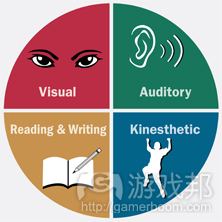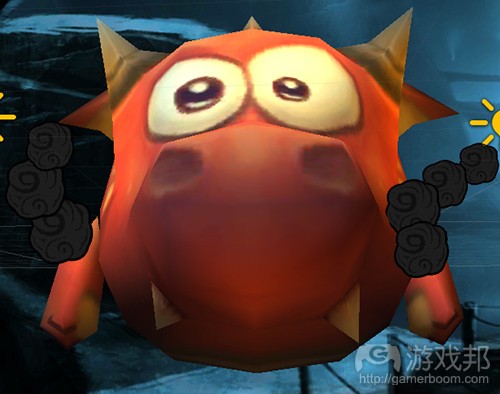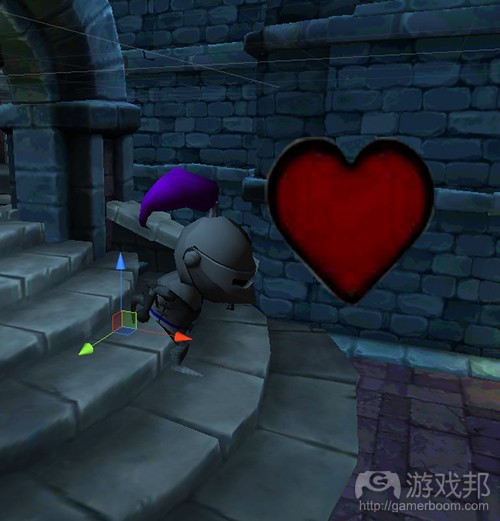如何更有效地在游戏中教授玩家游戏
作者:Max Pears
我一直忙于《全境封锁》的发行中,它现在表现很好。但不要误会,我还希望能够完善其中的许多内容,不过从总体看来我对这款游戏还是很喜欢且满怀骄傲的。而今天我们将讨论的要点其实是关于“教授玩家”。
尽管现在已经是2016年,而玩了40年游戏的我仍然发现许多游戏都不能有效使用这一技巧,即许多游戏剥夺了玩家的控制权并迫他们不得不去浏览教授自己如何游戏的长篇大论。
免责声明:我将要阐述的内容并非适合所有的游戏。
这对我来说非常疯狂,我理解这种方法会因为时间的原因而失效。但这的确是一种糟糕的实践而我只是希望人们能够将其牢记于心,并在创造全新机制或谜题时尽量去避开它。那么我将如何将其教授给玩家呢?
在开始前我想先声明为什么我认为这是一种糟糕的实践/教授方法。不管何时剥夺玩家的控制权都是一种冒险的做法。这可能导致玩家受挫并让他们只能在游戏告诉他们原因后才能采取行动。玩家之所以前来游戏便意味着他们希望能够尽快地深入游戏。
我们可以将其想成用户在使用iTunes前需要同意的苹果协议。我可以想象到90%以上的用户都因为文本太长而未浏览全部的合同内容,他们只是想要快速使用产品。同样的效果也会出现在你的游戏中,即如果你迫使玩家浏览许多文本内容,他们只会尽快略过它们,而这可能导致玩家因为略过了教程不能有效掌握游戏玩法而感到受挫。
关于学习的一个有趣的事实是,存在许多不同的学习风格。人们将适合其中一种或多种组合的学习风格。这些风格包括:
视觉
听觉
阅读和书写
动觉
(当然还有更多其它风格,这4种基本风格则是我将在本文侧重描述的)。
你可能会认为自己是个视觉学习者,没关系,我会鼓励你先停下来再认真想想自己到底属于什么风格的学习者。
下一个问题可能是,“Max,阅读和书写竟然是一种学习风格?”
这是个好问题,我会说请想想你的游戏是关于什么。玩家将在游戏中做什么?
他们是在玩游戏!所以现在作为设计师/创造者的我们需要仔细思考这种游戏风格在游戏中的吸引力是什么?即4种学习风格中的3种:视觉,听觉和动觉。
(我之前忘记提到的一点是,确保你是在一个安全区域教授玩家。这意味着玩家在学习全新内容时不会无缘无故死掉。)
视觉
我们可以使用视觉学习去呈现给玩家他们想要看到的内容,如敌人模式,房间的移动等等。《洛克人》便是一个典型的例子:
通过将某些内容直接呈现在玩家眼前,他们将能从一个安全的距离中看到游戏模式。玩家不仅不会受到任何伤害,也将在遭遇挑战前拥有足够的时间去了解游戏模式。
对于我来说这是教授玩家的第二重要方法,也是大多数游戏会呈献给玩家的方式。就像我们可以使用动画去教授玩家一些警示标识,如此他们在看到这些标识时便会清楚即将发生什么。
听觉
对于我来说听觉是作为设计师的我们最想使用的方式,我们希望以此提醒玩家他们需要注意的地方或者告诉他们已经完成了任务。(当然并非所有游戏都适合这种方法。)
在《全境封锁》中,“bwahm”的声音便是提醒玩家任务完成的声音。基于这种方式玩家便会清楚自己的任务已经完成了。设计师也将使用这种方法作为警示标识。
就像在《蘑菇队长》的视频中我们会听到龙每次在要做些什么的时候都会发出一些声音。如此玩家便可以在听到这些声音的时候采取行动并从中学到每种声音的含义。
动觉
在我看来这是教授玩家的最重要方式。我们必须信任我们的系统,我们的世界以及最重要的玩家。如此他们便能够理解我们想要传递给他们的内容。
在游戏中添加动觉学习非常重要,并且必须让玩家觉得他们可以基于自己的节奏学到东西。
一旦玩家觉得自己精通了某些内容,作为设计师的我们便可以适当调整规则并提供给玩家较大的挑战内容。
对此我最后的观点是,如果你觉得自己必须为玩家写下某些内容,也请你先停下来想想这些内容是否能够呈现在图像或视频中?你必须清楚图像永远比文本有趣得多,文本只会是你最不必要的选择。
最后让我列举一些我用于教授玩家的例子:
视觉:
你可以发现龙身上带有一些粒子和光,这便是在告诉玩家将发生某些事,他们需要为此做好准备。
我同时也设置了玩家在遭遇撞击时心会掉落,并且添加了一个呼噜声告诉玩家他们遭遇了撞击。
图片:
我知道这并非教授玩家的最佳方式,但是玩家在看到这张图后便知道自己需要做什么了。
(本文为游戏邦/gamerboom.com编译,拒绝任何不保留版权的转发,如需转载请联系:游戏邦)
Teaching the Player: Don’t Use Words
by Max Pears
Hey guys,
Hope all is well with everyone. Sorry it has been a while. I have been pretty busy with the launch of ‘The Division,’ which has gone down pretty well. Do not get me wrong, there are things I wish I could have improved on, but overall I happy and proud of the game. Anyway going off topic there, today’s focus is ‘Teaching the Player’.
Despite it being 2016 and what has almost been 40 years of gaming I still see this HORRIBLE technique used in games, in which the game takes control away from the player and forces the player to read a novel to teach them how to play the game.
*Disclaimer* what I am about to say may not apply to all games.
This is CRAZY to me, as we have amazing people and I understand that this sort of method may have been rushed out because of time. However it is bad practise and I just want to address it so that people can keep this in mind, when creating a new mechanic or puzzle…….. How am I going to teach this to the player?
(For a great idea on how to teach and expand on this watch this video below as I will expand on this later.)
Before we go into this I want to state why I believe it to be a bad practise/teaching method. Any time that control is taken away from the player is a risky move. This could cause frustration and only allowing them to move after they have done what has been told causes a rebelling feeling within players. Players have come to PLAY the game. This means they will get to the game as fast as possible.
Think of it like the ‘Apple’ agreement users must agree to before using iTunes. I imagine that 90+% of users do not read all of that contract due to the amount of text, they just want to use the product as quick as possible. Same effect as if you force the player to read, they will skip as fast as they can to play the game, which leads to frustration as they didn’t learn because they skipped the tutorial.
Now an interesting fact on learning is that there are multiple learning styles. People fall under one or a mix of styles. These styles are:
Visual
Auditory
Reading and Writing
Kinaesthetic
(There are supposedly more but these are the 4 basics and the ones I would like to focus on).
So you may be thinking ‘I am such a visual learner’ which is great and I do encourage you just to stop for a second and think what style of learner you are. Okay got it? Great.
Now the next question may be, ‘but Max it says reading and writing are a learning style! So what is your problem?’
Good question good sir or lady, I would say think about what a game is. What do players do with a game?
They play! So now we as designers/creators need to think well which of these appeals to this style of play in games? It’s 3 out of the 4 learning styles, Visual, Auditory, and Kinaesthetic.
(Key point that I forgot to mention earlier, make sure when teaching the player that they are in a safe area. Meaning the player will NOT die while trying to learn this new obstacle.)
Visual:
Visual learning is great as we can use this to show the player what they need to look out for, such as an enemy pattern, movement of the room etc. A great example is MegaMan:
By having something happen directly in front of the player they can see pattern from a safe distance. The player is also not in harm’s way either, giving them time to learn the pattern before advancing to the challenge its self.
To me this is the second most important one in teaching the player, simply as most games provide visuals for the player to look at. So with animation we can teach the player warning signs so that they can instantly see what is going to happen.
As you can see the first thing the Dragon boss does is animate to tilt his head back, with wind being sucked into his nostrils. The player is unsure what is going to happen, yet he is aware something is going to happen. This is visually teaching the player the boss’s pattern.
Auditory:
To me auditory is a something we as designers sprinkle on top to help add emphases to the player that they should be careful or have finished their task. (This may not be true for all games and if you have an example of the player learning from a pure auditory standard then please tweet me @maxpears and let me know).
Here in the division that kind of ‘bwahm’ noise is the sound of the mission being completed. This way if the player hears this sound then they know that they have done well and their work is done. Designers will also use this as a warning sign as well.
If you go back to the ‘Captain Toad’ video you will hear the dragon making noises each time he is about to do something. This way the player can now associate a noise with an action and will learn what that particular noise means.
Kinaesthetic:
In my view, this is the most important way to teach the player. We must entrust in our systems, world and most importantly players. That they will understand what we are trying to communicate. If we go back to the first video I linked in this blog:
We can see that the level design is set up in a way which encourages the player to experiment and master what they are trying to learn. This is important with kinaesthetic learning within games, starting off the player must feel that they can learn at their own pace.
Once they have a feeling that they have mastered this then, we as a designers bend the rules slightly and a little twist in to challenge the player.
My final points on this is, if you feel you have to write something out for the player to read just stop and think can this be shown in a picture or video format? Remember a picture speaks a thousand words and is far more enjoyable. Text should Only be a last resort.
Chest Quest
So just some examples on what I have done to help teach the player.
Visual:
Here you can see the dragon with particles and lights, signalling to the player that something is about to happen, so get ready.
I have also added a the heart falling from the player once he has been hit and a grunt noise so player know they have been hit.
Kinaesthetic:
This starting area is long because it allows the player to mess around and try new things in a safe area. I want to encourage this experimental phase so they player doesn’t always feel as if I am holding their hand.
Pictures:
I know this isn’t the best way to teach the player, but the player knows what they need to do after one look at this picture.(source:Gamasutra)
上一篇:VR发展道路上的重重障碍
下一篇:创造还是购买一个游戏分析系统?












































 闽公网安备35020302001549号
闽公网安备35020302001549号